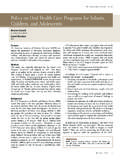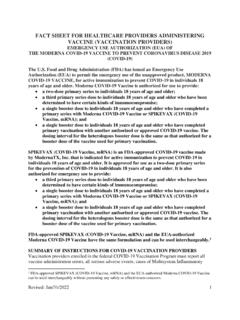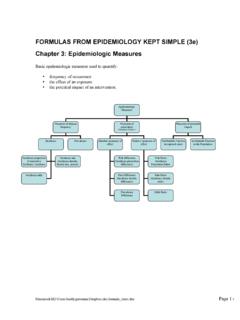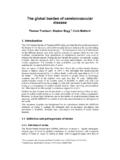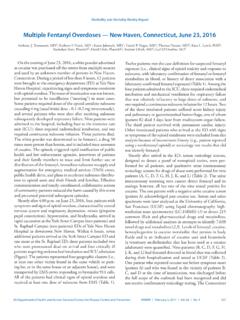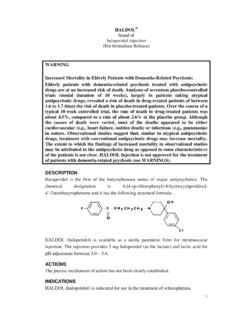Transcription of Guideline on Use of Local Anesthesia for Pediatric Dental ...
1 156 CLINICAL GUIDELINESrEfErENCE mANUAL v 32 / N o 6 10 / 11 PurposeThe American Academy of Pediatric Dentistry (AAPD) intends this Guideline to help practitioners make decisions when using Local Anesthesia to control pain in infants, children, adoles-cents, and individuals with special health care needs during the delivery of oral health revision included a new systematic literature search of the MEDLINE/Pubmed electronic database using the following parameters: Terms: Dental Anesthesia , Dental Local Anesthesia , and topical Anesthesia ; Field: all fields; Limits: within the last 10 years, humans, English, and clinical trials. One thousand one hundred thirty articles matched these criteria. Papers for review were chosen from this list and from references within selected articles. When data did not appear sufficient or were inconclu-sive, recommendations were based upon expert and/or consen-sus opinion by experienced researchers and Local Anesthesia is the temporary loss of sensation including pain in one part of the body produced by a topically-applied or injected agent without depressing the level of consciousness.
2 Prevention of pain during Dental procedures can nurture the relationship of the patient and dentist, building trust, allaying fear and anxiety, and promoting a positive Dental attitude. The technique of lo-cal anesthetic administration is an important consideration in the behavior guidance of a Pediatric patient. Age-appropriate nonthreatening terminology, distraction, topical anesthetics, proper injection technique, and nitrous oxide/oxygen analgesia/anxiolysis can help the patient have a positive experience during administration of Local ,2 In Pediatric dentistry, the Dental professional should be aware of proper dosage (based on weight) to minimize the chance of toxicity and the prolonged duration of Anesthesia , which can lead to accidental lip or tongue trauma. Knowledge of the gross and neuroanatomy of the head and neck allows for proper placement of the anesthetic solu-tion and helps minimize complications (eg, hematoma, trismus, intravascular injection).
3 Familiarity with the patient s medical history is essential to decrease the risk of aggravating a medical condition while rendering Dental care. Appropriate medical con-sultation should be obtained when needed. Many Local anesthetic agents are available to facilitate man-agement of pain in the Dental patient. There are 2 general types of Local anesthetic chemical formulations: (1) esters (eg, procaine, benzocaine, tetracaine); and (2) amides (eg, lidocaine, mepiva-caine, prilocaine, articaine).3 Local anesthetics are vasodilators; they eventually are absorbed into the circulation, where their systemic effect is related directly to their blood plasma Vasoconstrictors are added to Local anesthetics to constrict blood vessels in the area of injection. This lowers the rate of absorption of the Local anesthetic into the blood stream, thereby lowering the risk of toxicity and prolonging the anesthetic action in the Epinephrine is contraindicated in patients with Its dose should be kept to a minimum in patients receiving tricylic antidepressants since dysrhythmias may occur.
4 Levonordefrin and norepinephrine are absolutely contraindi-cated in these Patients with significant cardiovascular disease , thyroid dysfunction, diabetes, or sulfite sensitivity and those receiving monoamine oxidase inhibitors, tricyclic antide-pressants, or phenothiazines may require a medical consultation to determine the need for a Local anesthetic without ,7 When halogenated gases (eg, halothane) are used for general Anesthesia , the myocardium is sensitized to epinephrine. Such situations dictate caution with use of a Local Amide-type Local anesthetics no longer are contraindicated in patients with a family history of malignant hyperthermia, an abnormal elevation in body temperature during general anes-thesia with inhalation anesthetics or ,8 If a Local anesthetic is injected into an area of infection, its onset will be delayed or even The inflammatory process in an area of infection lowers the pH of the extracellular tissue from its normal value ( ) to 5 to 6 or lower.
5 This low pH inhibits anes-thetic action because little of the free base form of the anesthetic Guideline on Use of Local Anesthesia for Pediatric Dental Patients Originating Council Council on Clinical AffairsReview Council Council on Clinical AffairsAdopted 2005 Revised 2009 AmErICAN ACADEmy of Pediatric DENtIS try CLINICAL GUIDELINES 157is allowed to cross into the nerve sheath to prevent conduction of nerve Inserting a needle into an active site of infection also could lead to possible spread of the anestheticsThe application of topical anesthetic may help minimize dis-comfort caused during administration of Local Anesthesia . Topi-cal anesthetic is effective on surface tissues (2-3 mm in depth) to reduce painful needle penetration of the oral ,11 A variety of topical anesthetic agents are available in gel, liquid, ointment, patch, and aerosol forms. The topical anesthetic benzocaine is manufactured in concentrations up to 20%; lidocaine is available as a solution or ointment up to 5% and as a spray up to a 10% Benzocaine has a rapid onset.
6 Benzocaine toxic (overdose) reactions are virtually unknown. Localized allergic reactions, however, may occur after prolonged or repeated Topical lidocaine has an exceptionally low incidence of allergic reactions but is absorbed systemically and can combine with an injected amide Local anesthetic to increase the risk of Compounded topical anesthetics also are ,15 Two of the more common formulations contain 20% lidocaine, 4% tetracaine, and 2% phenylephrine or 10% lidocaine, 10% prilo-caine, 4% tetracaine, and 2% Compounded topical anesthetics have been used in orthodontic procedures for placement of mini-screw implants to aid tooth movement,14,16 as well as in Pediatric dentistry to anesthetize palatal tissues prior to injection and for extraction of loose primary teeth without the need for an injection. They contain high doses of both amide and ester agents and are at risk for side The US Food and Drug Administration does not regulate compound-ed topical anesthetics and recently issued warning about their ,18 Recommendations: 1.
7 Topical anesthetic may be used prior to the injection of a Local anesthetic to reduce discomfort associated with needle penetration. 2. The pharmacological properties of the topical agent should be understood. 3. A metered spray is suggested if an aerosol preparation is selected. 4. Systemic absorption of the drugs in topical anesthetics must be considered when calculating the total amount of anesthetic AAPD recommends further investigation regarding the safety and efficacy of compounded topical anesthetics and their applications for Pediatric Dental of syringes and needlesThe American Dental association (ADA) has established standards for aspirating syringes for use in the administration of Local ,20 Needle selection should allow for pro- found Local Anesthesia and adequate aspiration. Larger gauge needles provide for less deflection as the needle passes through soft tissues and for more reliable The depth of in-sertion varies not only by injection technique, but also by the age and size of the patient.
8 Dental needles are available in 3 lengths: long (32 mm), short (20 mm), and ultrashort (10 mm). * Total dosage should be based on child s weight and should never exceed maximum total dosage. Table 1. INjECtAb LE Local ANESthE tICS Duration in minutes3,23 Maxillary infiltration Mandibular blockMaximum dosage23 Maximum total dosage23*AnestheticPulpSoft tissuePulpSoft tissuemg/kgmg/lb(mg) 2% plain55-10 2%+1:50,000 epinephrine6017085190 2%+1:100,000 3% plain259040165 2%+1:100,000 epinephrine6017085190 2%+1:20,000 4%+1:100,000 4% plain2010555190 4%+1:200,000 +1:200,000 epinephrine40340240440158 CLINICAL GUIDELINES rEfErENCE mANUAL v 32 / N o 6 10 / 11 Needle gauges range from size 23 to 30. Needle breakage is a rare occurrence . The primary cause of needle breakage is weakening the needle due to bending it before insertion into the soft tissues; another cause is patient movement after the needle is already Recommendations: 1.
9 For the administration of Local Dental Anesthesia , den- tists should select aspirating syringes that meet ADA standards. 2. Short needles may be used for any injection in which the thickness of soft tissue is less than 20 mm. A long needle may be used for a deeper injection into soft Any 23- through 30-gauge needle may be used for intraoral injections, since blood can be aspirated through all of them. Aspiration can be more difficult, however, when smaller gauge needles are An extra-short, 30-gauge is appropriate for infiltration 3. Needles should not be bent if they are to be inserted into soft tissue to a depth of >5 mm or inserted to their hub for injections to avoid needle Local anesthetic agentsLocal amide anesthetics available for Dental usage include lidocaine, mepivacaine, articaine, prilocaine, and bupivacaine (Tables 1 and 2).
10 Absolute contra- indications for Local anesthetics include a docu- mented Local anesthetic True allergy to an amide is exceedingly rare. Allergy to one amide does not rule out the use of another amide, but allergy to one ester rules out use of another A bisulfate preservative is used in Local anesthetics containing epinephrine. For patients having an al- lergy to bisulfates, use of a Local anesthetic without a vasoconstrictor is Local anesthetics without vasoconstrictors should be used with cau- tion due to rapid systemic absorption which may result in A long-acting Local anesthetic (ie, bupivacaine) is not recommended for the child or the physically or mentally disabled patient due to its prolonged effect, which increases the risk of soft tissue in- Claims have been made that articaine can diffuse through hard and soft tissue from a buccal infiltration to provide lingual or palatal soft tissue Studies using articaine, lidocaine, and prilocaine, however, did not substantiate these ,24 Epinephrine decreases bleeding in the area of in-jection.




